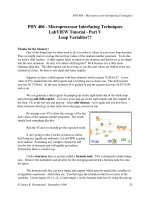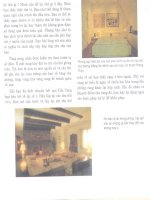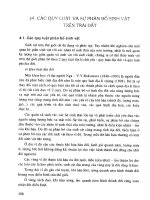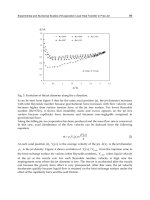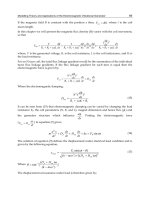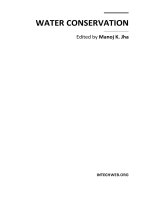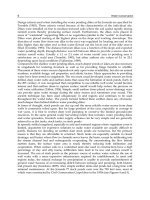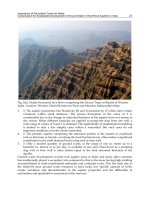Water Conservation Part 5 ppt
Bạn đang xem bản rút gọn của tài liệu. Xem và tải ngay bản đầy đủ của tài liệu tại đây (937.83 KB, 15 trang )
Alternative Management Practices for
Water Conservation in Dryland Farming: A Case Study in Bijar, Iran
51
the precipitation water is converted into snow. The soils of the region have low organic
matter and nitrogen, with medium amount of phosphorus and high potassium content. The
soil had been cultivated since long time ago. The climate of the area is characterized by a
cold and snowy winter and a warm and dry summer with high evapotranspiration potential
(in excess of 1500 mm in an evaporimetric tank).
2.2 Experimental site and design
2.2.1 Tillage treatments
Three tillage treatments were imposed during seed bed preparation. The plot layout was
arranged using a randomized complete block design with four replicates. Plowing
operations were carried out in April 2003 and disking was performed twice in September of
2003.
Tillage systems used were as follows:
Moldboard plow (MP) (200 mm depth) and twice offset disking (70 mm depth).
Chisel plow (CP) (300 mm depth) and twice offset disking (70 mm depth).
Deep plow (DP) with subsoiler (450 mm depth) and twice offset disking (70 mm depth).
The experimental design for each soil type was a spilt-split plot with three tillage systems as
main plots, manure applications (no application, application of 3 mm thickness of farmyard
manure (FM) on soil surface after sowing and mix same amount of FM with the soil surface
(70 mm depth before sowing) as split plots, and planting (no planting and planting) as split–
split plots. Each plot size was 2 m × 20 m in four replications.
Fertilizer including urea, ammonium phosphate, and microelements (Zn, Mn, Fe and Cu)
were applied before sowing according to soil analysis results and recommendation rates.
Wheat (Triticum aestivum L.) seeds (cultivar Sardary) were sown (at a rate of 150 kg ha
-1
)
and weeding was done manually.
2.3 Runoff and soil loss
Runoff and soil loss were measured in each plot. The plot edges were made of solid
materials (wood plank). The edges of the plots were about 15 cm above the soil surface to
prevent input from splashes entering the plot from the surrounding areas and were
sufficiently embedded into the soil. Runoff and soil loss were measured by collecting the
runoff water in 40-liter capacity buckets (Khan and Ong, 1997), which were placed at the
bottom of each plot. The collection buckets were connected to the runoff plots via PVC
tubes, which collected both soil sediments and runoff water from the each plot after every
rainfall event. Sediment concentration was determined through sampling collected runoff
at the out let of each plot. Sediment content was determined by means of drying and
weighing (Inbar and Llerena, 2000). Sediment yield was assumed to be equal to the rate of
soil erosion. Runoff and sediment measurements were conducted from cultivation to
harvesting stages.
2.4 Measurement of soil properties
The measured soil properties were pH, CaCO
3
content, soil water content at field
capacity (FC) and permanent wilting point (PWP), organic matter (OM) content, particle
size distribution, electrical conductivity of saturation extract (ECe), cation exchange
capacity (CEC), and soil bulk density. Soil bulk density was measured on undisturbed
Water Conservation
52
core samples (Blake and Hartge, 1986). Particle size distribution was determined by the
Bouyoucos hydrometer method (Bouyoucos, 1962). Water infiltration rates were
determined in the soil surface of various treatments using a double-ring infiltrometer
(Bouwer, 1986). The CEC was determined according to method used for alkaline soils
(Bower et al., 1952). The pH and electrical conductivity were determined from a
saturated paste extract (Rhoades, 1982). The amount of CaCO
3
was determined by acid
neutralization method (Allison and Moodie, 1965) and the OM content was determined
by the potassium dichromate oxidation method (Nelson et al., 1982). The soil water
content was measured using gravimetric method. Water retention capacity was
measured at FC (− 33 kPa) and PWP (− 1500 kPa) (Gardner and Klute, 1986). Soil water
content was measured at depths of 1 to 100 cm in every 5 cm intervals by the gravimetric
method.
Wet aggregate stability was determined using the method of Kemper and Rosenau (Kemper
and Rosenau, 1986). Fifty grams of air-dried aggregates (3–5 mm diameter) from each soil
type was wet sieved through a 2 mm sieve. The sieving time was 10 min at 50 oscillations
per minute. The percent of aggregate size bigger than 2 mm was calculated and used as an
aggregate stability index among treatments. Soil compaction was determined using the
Cone index readings which were taken with a hand held 13-mm diameter, 30 ° cone tip
penetrometer (Carter, 1967) at soil surface of each plot. The soils were sampled to determine
their properties during the months of October (2003), April (2004) and June (2004) to
represent the planting time, middle and end of wheat growth, respectively. The dry weight
of roots per plot was measured at harvest.
3. Result and discussions
The soil properties of the experimental sites are shown in Table 1. There were considerable
differences between the various soils in term of soil pH, CaCO
3
, FC, PWP, texture, CEC, and
slope. Results of sandy loam and clay loam soils were similar to loam soil; therefore, only
result of loam soil is presented in this chapter. Figure 1 shows the location of the
experimental site which is adjacent to a watershed areasituated behind the Golbolagh
reservoir dam.
Soils
Slope
(%)
FC PWP CaCO
3
OM
EC
e
(dS m
− 1
)
pH
CEC
(cmol
c
kg
− 1
)
(g kg
-1
)
Sandy loam
4 210 95 130 14 1.1 7.1 11
Loam
8 270 107 140 13 0.8 7.5 15
Clay loam
5 300 114 90 16 0.7 7.3 18
FC: field capacity; PWP: permanent wilting point; ECe: electrical conductivity of saturation extract;
CEC: cation exchange capacity; OM: organic matter.
Table 1. The properties of the soils
Alternative Management Practices for
Water Conservation in Dryland Farming: A Case Study in Bijar, Iran
53
Fig. 1. Location of experimental site (a) and location of site in the watershed behind the
Golbolagh dam (b).
Water Conservation
54
Fig. 2. The percentage of aggregates bigger than 2 mm among treatments in April (2004).
Values followed by the same letter are not significantly different (P < 0.05).
3.1 Aggregate stability
Soil aggregate stability can be evaluated by determiningthe % of aggregates bigger than 2 mm
(Hajabbasi and Hemmat, 2000). The soil aggregates bigger than 2 mm at different treatments
are shown in Figure 2. There was significant difference (P < 0.05) in soil aggregates percentage
among treatments. Non-moldboard plow (MP) had the lowest aggregate percentage. Mixing
farmyard manure (FM) with soil increased the aggregate percentage but was not significantly
different (P < 0.05). Application of the FM as mulch on soil surface enhanced the aggregate
percentage significantly. The percentage of aggregates bigger than 2 mm in non-mulched
chisel plow (CP) was higher than non-mulched MP. The application of FM as mulch in CP
increased the percentage of aggregates significantly (P < 0.05). Mixing the FM with soil in the
CP increased aggregates percentage but it was not statistically significant. The percentage of
Alternative Management Practices for
Water Conservation in Dryland Farming: A Case Study in Bijar, Iran
55
aggregate bigger than 2 mm in deep plow (DP) was more than MP and CP. Mulched DP had
highest percentage of aggregate. Mixing of FM with DP soil increase the aggregate percentage
compared to non-mulched DP but it was not significant.
Application of FM as a mulch on all kind of plowing increased the percentage of soil aggregates
in soil surface. This result is in agreement with result of Shirani et al. (2002) who showed that
the mixing of 30 and 60 Mg ha
-1
of FM increased the aggregate stability. However, there is no
reported data on the application of FM as a mulch and aggregate stability. As mentioned in the
materials and methods section, the thickness of FM mulch was 3 cm and if we calculate the
weight of FM per ha, it is around 5 Mg ha
-1
. Although the amount of FM applied was low, it
increased the aggregate stability drastically and improved the soil structure.
3.2 Soil cone index
Soil compaction is normally determined by measuring its penetration resistance with a
penetrometer and the value obtained is referred to as a soil cone index. The soil cone indices
of the treatments are shown in Figure 3. There was significant difference (P < 0.05) in soil
cone index among treatments. The soil cone indexes in mulched treatments were much
lower than either non-amended treatments or treatments of FM mixed with the soil. Lowest
cone index was observed in mulched-DP and non-mulched MP which had the highest cone
index. Mixing FM with the soil decreased soil cone index compare to the same tillage
without application of FM. The percentage of soil aggregate bigger than 2 mm was
negatively correlated with the cone index (Figure 4.). Soil cone index decreased with
increasing amount of aggregates bigger than 2 mm.
Fig. 3. Cone index of treatments in April (2004). Treatments followed by the same letter are
not significantly different (P < 0.05).
Water Conservation
56
Soil crust appeared when soil aggregates are broken down into smaller particles
(Bissonnais, 1996; Le Bissonnais et al., 1989). The high cone index values observed in non-
mulched MP could be due to the restriction factor for wheat emergence and water
infiltration; hence, higher soil cone index could be a potential limiting factor for plant
growth and
it is expected that precipitation water will be lost as surface runoff.
Fig. 4. Correlation between percentage of soil aggregate bigger than 2 mm and soil cone
index.
3.3 Soil bulk density
The soil bulk densities measured at different depths of treatments are shown in Figure 5.
There was no difference in soil bulk density between non-mulched MP, mulched MP and
mixed FM with MP treatments at depths lower than 10 cm. However, mulched MP had the
lowest bulk density at the soil surface (5 cm depth). Mixing FM with soil decreased the soil
bulk density at the upper depths (5 and 10 cm depths) compared to same non-mulched MP
treatment. The highest bulk density in non-mulched MP was observed at 25 cm depth and
this is possibly due to the presence of hardpan at that depth. The bulk densities in the MP
treatments increased at depths lower than 20 cm. This is reasonable because MP is able to
loosen the upper 20 cm soil layer and below this depth, the soil can be compacted by
moldboard during tillage operation. Chisel plow treatments had lower bulk density at 25 cm
depth in contrast to MP treatments. This data shows that hardpan was broken by the CP
operation. Bulk density was lowest in the DP treatments. This plowing method decreased
soil bulk density atall depths except at 50 cm. The addition of FM as mulch helped to lower
the surface soil bulk density in all tillage systems. This result is consistent with the finding
of Lampurlanés, (2003) who showed that deep tillage could keep soil to be porous. This
result also in agreement with Shirani et al. (2002) who reported that farmyard manure
significantly decreased soil bulk density on the row tracks of field.
Alternative Management Practices for
Water Conservation in Dryland Farming: A Case Study in Bijar, Iran
57
Fig. 5. Soil bulk density of treatments versus depths measured during April 2004.
Horizontal bars represent the common LSD (P < 0.05) by depth for all treatments.
3.4 Infiltration rate
The infiltration rates of the treatments are shown in Figure 6. The infiltration rate in
mulched DP was the highest, while non-mulched MP had lowest rate. The infiltration rates
of the treatments were in the following order: mulched DP > mulched CP > DP + mixing FM
Water Conservation
58
= mulched MP > non-mulched DP = CP + mixing FM > non-mulched CP > MP + mixing FM
> non-mulched-MP. The results indicate that infiltration rates increased with the application
of mulch on soil surface in all tillage systems. Among the tillage systems studied, the DP
which has the lowest bulk density and cone index has the highest infiltration rate followed
by CP and MP. Application of FM as mulch in the all tillage treatments increased infiltration
rate. Mixing FM with soil increased infiltration rate but it was not as effective as the FM
mulch. This indicated that the addition of FM as a mulch helped improved soil structure
and increase water infiltration. This can be attributed to the fact that FM mulch can increase
aggregate stability, increase soil water content and decrease runoff. This finding is in
accordance with the results of Shirani et al. (2002), which showed that mixing 30 and 60 Mg
ha
-1
of farmyard manure increased soil hydraulic conductivity. However, there is no
reported study on the application of FM as mulch on soil surface in various tillage systems
after sowing. Only 3 to 4Mg ha
-1
of FM is required to cover the soil for FM to be used as a
mulch which is affordable to the farmers in the large area of dryland production of Iran.
This application method is also suitable for dry land production in other parts of world.
Fig. 6. Infiltration rate of the treatments during April (2004). Treatments followed by the
same letter are not significantly different (P < 0.05).
Alternative Management Practices for
Water Conservation in Dryland Farming: A Case Study in Bijar, Iran
59
Fig. 7. Soil water content of treatments in April and June (2004). Treatments followed by the
same letter are not significantly different (P < 0.05).
3.5 Soil water content
Effects of mulch and tillage treatments on water content in the soil profile, evaporation,
and availability of water for plant growth could not be studied in winter and autumn
because biomass production started in the April and plants needed water since beginning
of April to end of June. Soil water contents of treatments during April and June (2004) are
shown in Figure 7. There was a significant difference in soil water content among MP, CP
and DP in April. Soil water content was significantly (P < 0.05) higher in DP than CP and
MP during April. The lowest water content was observed in MP treated soils in April.
There was higher water content in soils treated with mulch compared to same treatment
without mulch. Soil water content of non-cultivated plot of DP with mulch was the
highest among the tillage treatments. The soil water content of non-cultivated plot of CP
with mulch was lower than the non-cultivated DP with mulch. However, non-cultivated
plot of CP with mulch had higher water content than non-cultivated plot of MP with
mulch. The water content in all planted treatments which had mulch was lowest. Higher
biomass in the mulch treated plots implied the higher water consumption in these
treatments. Conversely, in the non-planted mulch treatments for all tillage operations
(MP, CP and DP) water content were higher than same tillage systems without mulch.
The differences in water content in the non-planted treatments with planted treatments
could be due to reduced transpiration in the non-planted treatments. The water contents
of all treatment during June were decreased in comparison to April. The decrease in water
content could be ascribed to evaporation and possible drainage of water to a depth greater
than 100 cm. Our data suggest that FM mulch on soil surface was effective in conservation
of water and thus retaining more water in the soil than that in the other treatments. This
result is in agreement with previous result which showed the addition of municipal
Water Conservation
60
sewage sludge increased available water in the root zone mainly due to reduction in
evaporation (Agassi et al., 2004).
3.6 Runoff
Annual runoff for each treatment is presented in Table 2. Almost all precipitations occurred
in autumn 2003 and winter 2004 and then continued in April 2004. Precipitations were
extremely low after April 2004. Lack of rainfall in May and June (2004), i.e., during the plant
growth period, was considered as a vital aspect of water conservation and runoff control in
this area during the previous autumn and winter. Spreading FM mulch on the soils resulted
in decreased runoff of MP, CP and DP compared to the same tillage systems without mulch.
For example, in the case of MP, mulching could decrease 300 m
3
ha
-1
of runoff per year
compared to the non-mulched MP.
The amount of runoff in the CP and MP treatments was negligible and it was zero in the
mulched CP and DP (Table 2). Addition of FM as a mulch decreased the runoff of CP and
DP compared to the non-mulched CP and DP (Table 2). Therefore, it can be concluded that
the decrease in runoff is one of beneficial effects of FM mulch especially in the conventional
tillage system (MP). A decrease in runoff was related to the higher infiltration rate in
mulched treatments and this finding is in agreement with other studies which showed that
mulching was effective in controlling runoff in soils susceptible to sealing (Poesen and
Lavee, 1991; Saxton et al., 1981).
3.7 Soil loss
The trend of soil loss was similar to the trend of runoff among the treatments (Table 2). Soil
loss ranged from 0 kg plot
-1
year
-1
for mulched CP and MP to 193 kg plot
-1
year
-1
for non-
mulched MP. (Table 2). Less soil loss was measured on mulched MP treatment compared to
the non-mulched MP treatment. Mulching also decreased soil loss in CP and DP. However,
in some cases the differences between the mulched and non-mulched treatments was not
significant (P < 0.05). Overall, soil loss in all treatments of CP and DP was negligible.
Mulching significantly decreased the soil loss in some treatments by preventing the
impacts of raindrops on the soil aggregates (Figure 2) hence conserving the soil structure
(Figure 3) and as a result infiltration rates were higher in mulched treatments compared to
the non-mulched treatments (Figure 6). From theresults it can be concluded that mulching
was very useful to control soil erosion. This result is in agreement with the findings of
Döring et al. (2005) who reported that soil erosion was reduced by more than 97% in a rain
simulation experiment on a potato field of 8% slope with 20% crop cover compared to sils
without crop cover.
3.8 Wheat emergence, dry weight of roots and grain yield
Wheat emergence was significantly influenced by mulching and tillage (Table 2). Wheat
emergence in April (2004) was low under tillage systems without mulch. Mulching
increased the wheat emergence in all tillage systems (Table 2). The highest and the lowest
rates of wheat emergence were observed in mulched MP and non-mulched DP, respectively.
Although conservation tillage (non-mulched CP and non-mulched DP) were able to
decrease water and soil loss as runoff and sediment and prevented soil structure from being
degradation, there was less wheat emergence compared to the conventional tillage (non-
mulched MP). The decrease in wheat emergence rate in non-mulched CP and DP could be
Alternative Management Practices for
Water Conservation in Dryland Farming: A Case Study in Bijar, Iran
61
due to cracking of seeds at the end of autumn when the water freeze into ice . However,
mulching seems to decrease seed cracking in the mulched-CP and DP treatments. A
possible explanation for a decrease in wheat emergence in non-mulched MP is crusting was
induced by raindrops in this treatment.
Effects of tillage systems and mulching on dry weight of roots and grain yield were
significant (Table 2). Weight of roots and grain yield under all the tillage systems
generally increased with the application of mulch. Mulched MP had higher weight of
roots and grain yield than the non-mulched MP which could be explained by the higher
wheat emergence and higher water content for feeding the plant during the growth
period.
The grain yield was the highest in the mulched DP. Mulched CP had lower grain yield than
the mulched MP. Although non-mulched DP had high water content, the grain yield and
weight of roots were low probably because the absence of enough wheat emergences (Table
2). The existence of enough moisture in the soil profile (Figure 7) is not a sufficient condition
to have high amounts of yield. High wheat emergence is also necessary to have enough
plant population and economical grain yield. In the non-mulched CP and DP there was not
enough plant population to obtain an economical yield. This is the reason why farmers do
not prefer conservation tillage in this area. However, the addition of FM as mulch to the
tillage systems increased the yield drastically (approximately two folds) and solved the
problem of low grain yield often associated with the conservation tillage. The FM mulch
helped the soils to store enough water in the soil profile but at the same time did not reduce
the wheat emergence. Therefore, the FM mulch method is highly recommended for
conserving water in the arid and semi-arid regions without jeopardizing the grain yield of
wheat.
Treatments
Non-
mulched
MP
Mulched
MP
MP +
mixin
g
FM
Non-
mulched
CP
Mulched
CP
CP +
mixin
g
FM
Non-
mulched
DP
Mulched
DP
DP +
mixin
g
FM
Runoff
(m
3
/ plot year)
1.8 a
†
0.6 c 1.3 b 0.2 d 0 e 0.15 de 0.14 de 0 e 0.10 de
Soil loss
(kg / plot year)
193 a 53 c 114 b 67 c 0 e 29 d 59 c 0 e 11 e
Wheat emergence
per plot
7600 d 12072 a 9480 b 6037 f 8360 c 7320 d 5722 g 9317b 6681e
Dry weight of roots
(kg / plot)
6.96 e 10.26 c 7.99 d 6.79 e 11.89 b 7.19 de 7.57 d 15.63 a 7.90 d
Grain yield
(kg / plot)
4.87 g 8.78 c 6.40 e 5.93 ef 11.95 b 7.61 d 6.30 de 15.28 a 7.24 d
†
Means in a row followed by a different letter differ significantly based on the LSD at P < 0.05.
Table 2. Runoff, soil loss, wheat emergence, dry weight of roots and grain yield in various
treatments
Water Conservation
62
4. Conclusions
The objective of this study was to develop appropriate tillage and farm yard mulching
systems for conserving water and soil with the aim of improving the grain yield of wheat
(Triticum aestivum L.) of the cultivar Sardary. Three plowing treatments (MP, CP, and DP)
and three FM applications (no application, mixing with soil and application as mulch on soil
surface) were employed. From the results it can be concluded that:
Conservation tillage systems (CP and DP) increased soil water content in the soil profile
and decrease runoff and soil loss. However, the yield was not economical due to the
effect of ice damage on the winter wheat seed.
Application of FM as a mulch to the conservation tillage systems increased grain yield.
The mulched DP had the highest yield of wheat among the treatments.
Mulching increased infiltration, soil water content and yield in the conventional tillage
system (MP).
Mulching enhanced the wheat yield in all tillage systems and at the same time
conserves water and soil. Therefore, it is a good strategy to be adopted not only with
the conventional tillage system but also with the conservation tillage system which is
usually associated with low yield.
5. References
Agassi M., Levy G., Hadas A., Benyamini Y., Zhevelev H., Fizik E., Gotessman M., Sasson N.
(2004) Mulching with composted municipal solid wastes in Central Negev, Israel: I.
effects on minimizing rainwater losses and on hazards to the environment. Soil and
tillage research 78:103-113.
Allison L., Moodie C. (1965) Carbonate volumetric calcimeter method. Methods of analysis.
Agronomy Monogr:1389-1392.
Alvarez R., Steinbach H. (2009) A review of the effects of tillage systems on some soil
physical properties, water content, nitrate availability and crops yield in the
Argentine Pampas. Soil and tillage research 104:1-15.
Arshad M., Gill K. (1997) Barley, canola and wheat production under different tillage-
fallow-green manure combinations on a clay soil in a cold, semiarid climate. Soil
and tillage research 43:263-275.
Bahremand M., Afyuni M., Hajabbasi M., Rezainejad Y. (1999) Short and mid-term effects of
organic fertilizers on some soil physical properties. pp. 288-289.
Barzegar A., Asoodar M., Khadish A., Hashemi A., Herbert S. (2003) Soil physical
characteristics and chickpea yield responses to tillage treatments. Soil and tillage
research 71:49-57.
Baumhardt R., Jones O. (2002) Residue management and tillage effects on soil-water storage
and grain yield of dryland wheat and sorghum for a clay loam in Texas. Soil and
tillage research 68:71-82.
Bissonnais Y. (1996) Aggregate stability and assessment of soil crustability and erodibility: I.
Theory and methodology. European Journal of Soil Science 47:425-437.
Blake G.R., Hartge K. (1986) Bulk density. Agronomy (USA).
Bouwer H. (1986) Intake rate: Cylinder infiltrometer. Agronomy.
Alternative Management Practices for
Water Conservation in Dryland Farming: A Case Study in Bijar, Iran
63
Bouyoucos G.J. (1962) Hydrometer Method Improved for Making Particle Size Analyses of
Soils1. Agronomy Journal 54:464.
Bower C., Reitemeier R., Fireman M. (1952) Exchangeable cation analysis of saline and alkali
soils. Soil science 73:251.
Box Jr J.E., Langdale G. (1984) The effects of in-row subsoil tillage and soil water on corn
yields in the Southeastern coastal plain of the United States. Soil and tillage
research 4:67-78.
Busscher W., Bauer P. (2003) Soil strength, cotton root growth and lint yield in a
southeastern USA coastal loamy sand. Soil and tillage research 74:151-159.
Busscher W., Frederick J., Bauer P. (2000) Timing effects of deep tillage on penetration
resistance and wheat and soybean yield.
Busscher W., Bauer P., Frederick J. (2002) Recompaction of a coastal loamy sand after deep
tillage as a function of subsequent cumulative rainfall. Soil and tillage research
68:49-57.
Busscher W., Bauer P., Frederick J. (2006) Deep tillage management for high strength
southeastern USA Coastal Plain soils. Soil and tillage research 85:178-185.
Carter L.M. (1967) Portable penetrometer measures soil strength profiles. Agric. Eng 48:348-
349.
Derpsch R., Sidiras N., Roth C. (1986) Results of studies made from 1977 to 1984 to control
erosion by cover crops and no-tillage techniques in Paraná, Brazil. Soil and tillage
research 8:253-263.
Diaz F., Jimenez C., Tejedor M. (2005) Influence of the thickness and grain size of tephra
mulch on soil water evaporation. Agricultural Water Management 74:47-55.
Döring T.F., Brandt M., Heß J., Finckh M.R., Saucke H. (2005) Effects of straw mulch on soil
nitrate dynamics, weeds, yield and soil erosion in organically grown potatoes. Field
crops research 94:238-249.
Gardner W.H., Klute A. (1986) Water content. Methods of soil analysis. Part 1. Physical and
mineralogical methods:493-544.
Glsb T., Kulig B (2008) Effect of mulch and tillage system on soil porosity under wheat
(Triticum aestivum). Soil & tillage research 99:169-178.
Hajabbasi M., Hemmat A. (2000) Tillage impacts on aggregate stability and crop
productivity in a clay-loam soil in central Iran. Soil and tillage research 56:205-
212.
Hemmat A., Taki O. (2001) Grain yield of irrigated winter wheat as affected by stubble-
tillage management and seeding rates in central Iran. Soil and tillage research
63:57-64.
Hemmat A., Eskandari I. (2004a) Conservation tillage practices for winter wheat-fallow
farming in the temperate continental climate of northwestern Iran. Field crops
research 89:123-133.
Hemmat A., Eskandari I. (2004b) Tillage system effects upon productivity of a dryland
winter wheat-chickpea rotation in the northwest region of Iran. Soil and tillage
research 78:69-81.
Water Conservation
64
Hemmat A., Eskandari I. (2006) Dryland winter wheat response to conservation tillage in a
continuous cropping system in northwestern Iran. Soil and tillage research 86:99-
109.
Hemmat A., Ahmadi I., Masoumi A. (2007) Water infiltration and clod size distribution as
influenced by ploughshare type, soil water content and ploughing depth.
Biosystems engineering 97:257-266.
Hobbs P.R., Sayre K., Gupta R. (2008) The role of conservation agriculture in sustainable
agriculture. Philosophical Transactions of the Royal Society B: Biological Sciences
363:543.
Hoogmoed W., Stroosnijder L. (1984) Crust formation on sandy soils in the Sahel I. Rainfall
and infiltration. Soil and tillage research 4:5-23.
Inbar M., Llerena C.A. (2000) Erosion processes in high mountain agricultural terraces in
Peru. Mountain Research and Development 20:72-79.
Kemper W., Rosenau R. (1986) Aggregate stability and size distribution.
Khan A.A.H., Ong C.K. (1997) Design and calibration of tipping bucket system for field
runoff and sediment quantification. Journal of soil and water conservation
52:437.
Laddha K., Totawat K. (1997) Effects of deep tillage under rainfed agriculture on
production of sorghum (Sorghum biocolor L. Moench) intercropped with green
gram (Vigna radiata L. Wilczek) in western India. Soil and tillage research
43:241-250.
Lampurlanés J. (2003) Soil bulk density and penetration resistance under different tillage
and crop management systems and their relationship with barley root growth.
Agronomy Journal 95:526.
Le Bissonnais Y., Bruand A., Jamagne M. (1989) Laboratory experimental study of soil
crusting: Relation between aggregate breakdown mechanisms and crust stucture.
Catena 16:377-392.
Locke M.A., Bryson C.T. (1997) Herbicide-soil interactions in reduced tillage and plant
residue management systems. Weed Science:307-320.
Mahboubi A., Lal R., Faussey N. (1993) Twenty-eight years of tillage effects on two soils in
Ohio. Soil Science Society of America journal (USA).
Morin J., Rawitz E., Hoogmoed W., Benyamini Y. (1984) Tillage practices for soil and water
conservation in the semi-arid zone III. Runoff modeling as a tool for conservation
tillage design. Soil and tillage research 4:215-224.
Mosaddeghi M., Mahboubi A., Safadoust A. (2009) Short-term effects of tillage and manure
on some soil physical properties and maize root growth in a sandy loam soil in
western Iran. Soil and tillage research 104:173-179.
Mosaddeghi M., Hemmat A., Hajabbasi M., Alexandrou A. (2003) Pre-compression stress
and its relation with the physical and mechanical properties of a structurally
unstable soil in central Iran. Soil and tillage research 70:53-64.
Motavalli P., Anderson S., Pengthamkeerati P. (2003a) Surface compaction and poultry litter
effects on corn growth, nitrogen availability, and physical properties of a claypan
soil. Field crops research 84:303-318.
Alternative Management Practices for
Water Conservation in Dryland Farming: A Case Study in Bijar, Iran
65
Motavalli P., Stevens W., Hartwig G. (2003b) Remediation of subsoil compaction and
compaction effects on corn N availability by deep tillage and application of poultry
manure in a sandy-textured soil. Soil and tillage research 71:121-131.
Nelson D., Sommers L., Page A. (1982) Methods of soil analysis. Methods of soil
analysis 9.
Nitant H., Singh P. (1995) Effects of deep tillage on dryland production of redgram (Cajanus
cajan L.) in central India. Soil and tillage research 34:17-26.
Peterson G., Halvorson A., Havlin J., Jones O., Lyon D., Tanaka D. (1998) Reduced tillage
and increasing cropping intensity in the Great Plains conserves soil C. Soil and
tillage research 47:207-218.
Pikul Jr J., Zuzel J. (1994) Soil crusting and water infiltration affected by long-term tillage
and residue management. Soil Science Society of America (USA).
Poesen J., Lavee H. (1991) Effects of size and incorporation of synthetic mulch on runoff and
sediment yield from interrils in a laboratory study with simulated rainfall. Soil and
tillage research 21:209-223.
Rhoades J. (1982) Soluble salts. Methods of soil analysis. Part 2:167-179.
Roger-Estrade J., Richard G., Caneill J., Boizard H., Coquet Y., Defossez P., Manichon H.
(2004) Morphological characterisation of soil structure in tilled fields: from a
diagnosis method to the modelling of structural changes over time. Soil and tillage
research 79:33-49.
Sadegh-Zadeh F., Seh-Bardan B.J., Samsuri A.W., Mohammadi A., Chorom M., Yazdani
G.A. (2009) Saline Soil Reclamation By Means of Layered Mulch. Arid Land
Research and Management 23:127-136.
Saggar S., Newman R., Ross C., Dando J., Shepherd T. (2001) Tillage-induced changes to soil
structure and organic carbon fractions in New Zealand soils. Australian Journal of
Soil Research 39:465-489.
Saxton K., McCool D., Papendick R. (1981) Slot mulch for runoff and erosion control. Journal
of soil and water conservation 36:44.
Shirani H., Hajabbasi M., Afyuni M., Hemmat A. (2002) Effects of farmyard manure and
tillage systems on soil physical properties and corn yield in central Iran. Soil and
tillage research 68:101-108.
Su Z., Zhang J., Wu W., Cai D., Lv J., Jiang G., Huang J., Gao J., Hartmann R., Gabriels D.
(2007) Effects of conservation tillage practices on winter wheat water-use efficiency
and crop yield on the Loess Plateau, China. Agricultural Water Management
87:307-314.
Tejedor M., Jiménez C., Díaz F. (2002) Soil moisture regime changes in tephra-mulched
soils: implications for soil taxonomy. Soil Science Society of America Journal
66:202-206.
Unger P.W., Fulton L.J. (1990) Conventional-and no-tillage effects on upper root zone soil
conditions. Soil and tillage research 16:337-344.
Unger P.W., Jones O.R. (1998) Long-term tillage and cropping systems affect bulk density
and penetration resistance of soil cropped to dryland wheat and grain sorghum.
Soil and tillage research 45:39-57.
